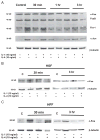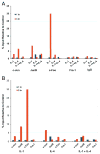IL-4 inhibition of IL-1 induced Matrix metalloproteinase-3 (MMP-3) expression in human fibroblasts involves decreased AP-1 activation via negative crosstalk involving of Jun N-terminal kinase (JNK)
- PMID: 23608488
- PMCID: PMC3757497
- DOI: 10.1016/j.yexcr.2013.04.010
IL-4 inhibition of IL-1 induced Matrix metalloproteinase-3 (MMP-3) expression in human fibroblasts involves decreased AP-1 activation via negative crosstalk involving of Jun N-terminal kinase (JNK)
Abstract
Matrix metalloproteinase-3 (MMP-3) over-expression is associated with tissue destruction in the context of chronic inflammation. Previous studies showed that IL-4 inhibits induction of MMP-3 by IL-1β, and suggested that AP-1 might be involved. Here we show that IL-1 induced binding of transcription factor AP-1 to the MMP-3 promoter consists primarily of c-Jun, JunB, and c-Fos and that binding of c-Jun and c-Fos is inhibited by the combination of cytokines while binding of Jun B is not. Mutation of the AP-1 site in the MMP-3 promoter decreased the ability of IL-4 to inhibit its transcription in transfected MG-63 cells. Western blotting showed that both cytokines activate Jun N-terminal kinase (JNK), but with somewhat different kinetics, and that activation of JNK by both cytokines individually is inhibited by the combination. These results indicate that IL-4 inhibition of MMP-3 expression is associated with reduction of IL-1 induced binding of active forms of the AP-1 dimer, while less active JunB-containing dimers remain, and suggest that these changes are associated with decreased activation of JNK.
Copyright © 2013 Elsevier Inc. All rights reserved.
Figures






Similar articles
-
IL-17 stimulates MMP-1 expression in primary human cardiac fibroblasts via p38 MAPK- and ERK1/2-dependent C/EBP-beta , NF-kappaB, and AP-1 activation.Am J Physiol Heart Circ Physiol. 2007 Dec;293(6):H3356-65. doi: 10.1152/ajpheart.00928.2007. Epub 2007 Oct 5. Am J Physiol Heart Circ Physiol. 2007. PMID: 17921324
-
Interleukin-6 increases rat metalloproteinase-13 gene expression through stimulation of activator protein 1 transcription factor in cultured fibroblasts.J Biol Chem. 1999 Oct 22;274(43):30919-26. doi: 10.1074/jbc.274.43.30919. J Biol Chem. 1999. PMID: 10521486
-
Interleukin-1 stimulates cytokines, prostaglandin E2 and matrix metalloproteinase-1 production via activation of MAPK/AP-1 and NF-kappaB in human gingival fibroblasts.Cytokine. 2005 Feb 21;29(4):159-68. doi: 10.1016/j.cyto.2004.10.009. Epub 2004 Dec 2. Cytokine. 2005. PMID: 15652448
-
Targeting inflammation by modulating the Jun/AP-1 pathway.Ann Rheum Dis. 2011 Mar;70 Suppl 1:i109-12. doi: 10.1136/ard.2010.140533. Ann Rheum Dis. 2011. PMID: 21339212 Review.
-
Self-organisation of early stress response in the biology of cancer.Postepy Biochem. 2024 May 23;70(1):33-38. doi: 10.18388/pb.2021_521. Print 2024 May 23. Postepy Biochem. 2024. PMID: 39016230 Review.
Cited by
-
Research Progress in the Pharmacological Activities, Toxicities, and Pharmacokinetics of Sophoridine and Its Derivatives.Drug Des Devel Ther. 2022 Jan 18;16:191-212. doi: 10.2147/DDDT.S339555. eCollection 2022. Drug Des Devel Ther. 2022. PMID: 35082485 Free PMC article. Review.
-
The Impact of Human Papilloma Viruses, Matrix Metallo-Proteinases and HIV Protease Inhibitors on the Onset and Progression of Uterine Cervix Epithelial Tumors: A Review of Preclinical and Clinical Studies.Int J Mol Sci. 2018 May 9;19(5):1418. doi: 10.3390/ijms19051418. Int J Mol Sci. 2018. PMID: 29747434 Free PMC article. Review.
-
The JNK pathway represents a novel target in the treatment of rheumatoid arthritis through the suppression of MMP-3.J Orthop Surg Res. 2020 Mar 4;15(1):87. doi: 10.1186/s13018-020-01595-9. J Orthop Surg Res. 2020. PMID: 32131874 Free PMC article.
-
Hyperbaric oxygen protects type II collagen in interleukin-1β-induced mandibular condylar chondrocyte via inhibiting the JNK/c-Jun signaling pathway.Oncotarget. 2017 Jul 17;8(36):60312-60323. doi: 10.18632/oncotarget.19294. eCollection 2017 Sep 1. Oncotarget. 2017. PMID: 28947973 Free PMC article.
-
Screening and bioinformatical analysis of differentially expressed genes in nasopharyngeal carcinoma.J Cancer. 2021 Jan 30;12(7):1867-1883. doi: 10.7150/jca.48979. eCollection 2021. J Cancer. 2021. PMID: 33753985 Free PMC article.
References
-
- Honig J, Rordorf-Adam C, Siegmund C, Wiedemann W, Erard F, et al. Increased interleukin-1 beta (IL-1 beta) concentration in gingival tissue from periodontitis patients. J Periodontal Res. 1989;24:362–367. - PubMed
-
- Stashenko P, Fujiyoshi P, Obernesser MS, Prostak L, Haffajee AD, Socransky SS, et al. Levels of interleukin 1 beta in tissue from sites of active periodontal disease. J Clin Periodontol. 1991;18:548–554. - PubMed
-
- Cheung NT, Dawes PT, Poulton KV, Ollier WE, Taylor DJ, Mattey DL, et al. High serum levels of pro-matrix metalloproteinase-3 are associated with greater radiographic damage and the presence of the shared epitope in patients with rheumatoid arthritis. J Rheumatol. 2000;27:882–887. - PubMed
-
- van den Berg WB, Bresnihan B, et al. Pathogenesis of joint damage in rheumatoid arthritis: evidence of a dominant role for interleukin-I. Baillieres Best Pract Res Clin Rheumatol. 1999;13:577–597. - PubMed
-
- Shapira L, van Dyke TE, Hart TC, et al. A localized absence of interleukin-4 triggers periodontal disease activity: a novel hypothesis. Med Hypotheses. 1992;39:319–322. - PubMed
Publication types
MeSH terms
Substances
Grants and funding
LinkOut - more resources
Full Text Sources
Other Literature Sources
Research Materials
Miscellaneous

